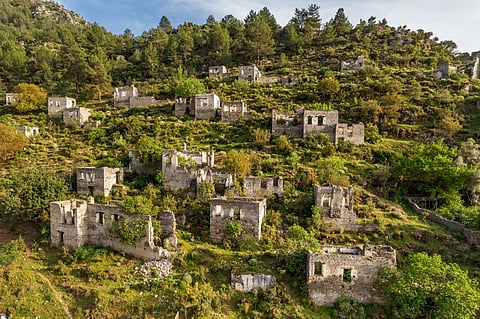Offbeat Alert: Here's Why You Should Visit This Ghost Town During Your Türkiye Trip
What is it about ghost villages that fascinates us? Once full of community and life, a site where people went about the ups and downs of living, now left abandoned to the elements, plants, trees, birds and animals to use for their own purposes. While Türkiye has many marvels to explore, from its natural wonders to archaeological ruins, a less well-known destination that you should make time for is Kayaköy.
Located in the Fethiye district of Muğla province, the once-bustling town is now a desert of roofless stone buildings and weathered streets. Originally built in the 1700s, the town was called Karmylassos in Greek and was home to as many as 10,000 Greek Orthodox residents by the early 20th century, but it became a ghost town in the early 1920s.
Here’s how Kayaköy became a ghost town and what you can expect from a visit there today.
A Bloody History
From around the 14th to early 20th centuries, Kayaköy (“Rock Village”) was a peaceful town made up of Greek-speaking Christians and Anatolian Muslims during Ottoman rule. Both communities celebrated religious festivals together, congregated at local cafés to shoot the breeze, studied and played together. However, following the events of the Greco-Turkish War of 1919–1922, which Türkiye won, and the massacres of Greeks and other Christian minorities in the Ottoman Empire during World War I, the town was quickly depopulated of its 6,500 Greek Orthodox residents. The former inhabitants were deprived of their properties and became refugees in Greece. The Treaty of Lausanne in 1923, signed after the Greco-Turkish war, mandated a population exchange between Greece and Türkiye, which barred the return of any prior Greek Orthodox refugees to their homes in Türkiye permanently and expelled Greece's Muslim citizens permanently to Türkiye.
What was once a harmonious community ended in conflict, violence and pain. In 1957, a 7.1 magnitude earthquake dealt a finishing blow to the town, destroying most of its buildings. Homes and businesses around the valley floor were later restored or rebuilt, but the hillside homes and buildings were left untouched. The approximately 350 buildings which still stand today consist of homes, schools, shops, cafés, chapels, churches, fountains and cisterns.
Kayaköy In Culture
The town has been featured in cultural materials over the years. Australian actor Russell Crowe filmed the last sequences of his 2014 film “The Water Diviner” around an old church of Kayaköy. Nearby residents had the opportunity to act as extras in the film. Meanwhile, the 2004 novel “Birds Without Wings” by Louis de Bernière is set in a fictionalised version of Kayaköy during World War I and the last days of the Ottoman Empire.
During your visit, check out the Kato Panagia Church, whose faded frescoes, vaulted ceilings and arches tell the story of another era. The Türkiye government has planned to develop one-third of the ancient village in addition to the construction of a hotel. The village is lit up at night, adding to the mysterious and spooky effect of the place.
How To Reach Kayaköy
The nearest airport is Dalaman (DLM), 56 kilometres away. Minibuses from the towns of Fethiye, Ölüdeniz and Hisarönü run to Kayaköy every 30 to 60 minutes. During summer, you can visit Kayaköy each day of the week between 9AM-8PM.
Best Time To Visit Kayaköy
The ideal time to visit Kayaköy is during spring or autumn when the weather is pleasant and not overly hot. If you’re visiting in the peak summer months, consider going in the evening when the temperatures are cooler and the crowds of day-trippers have dispersed.


